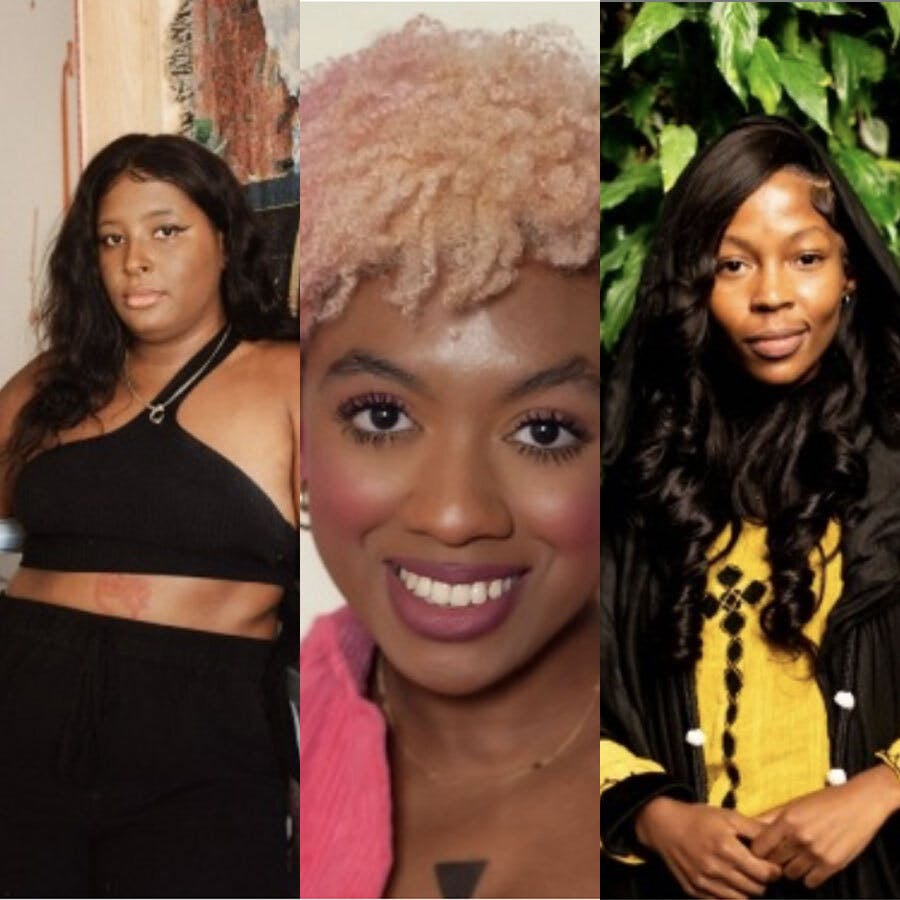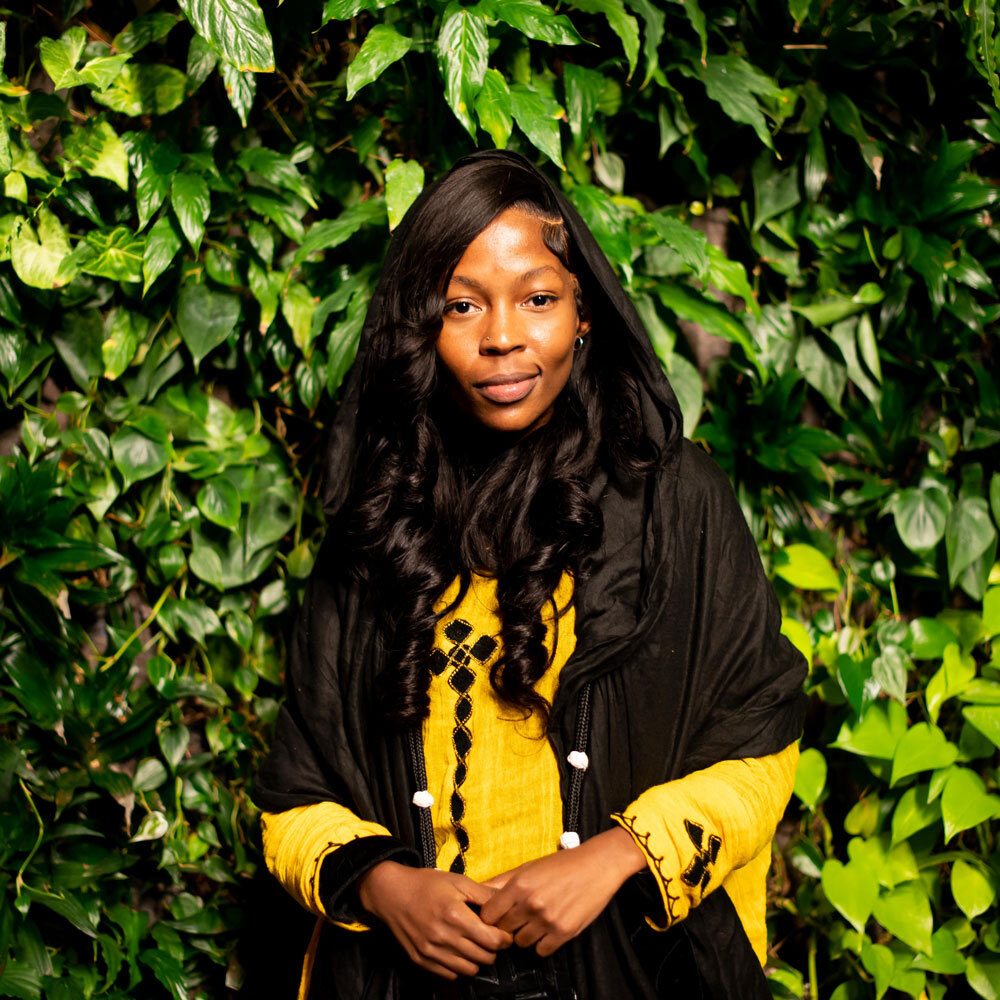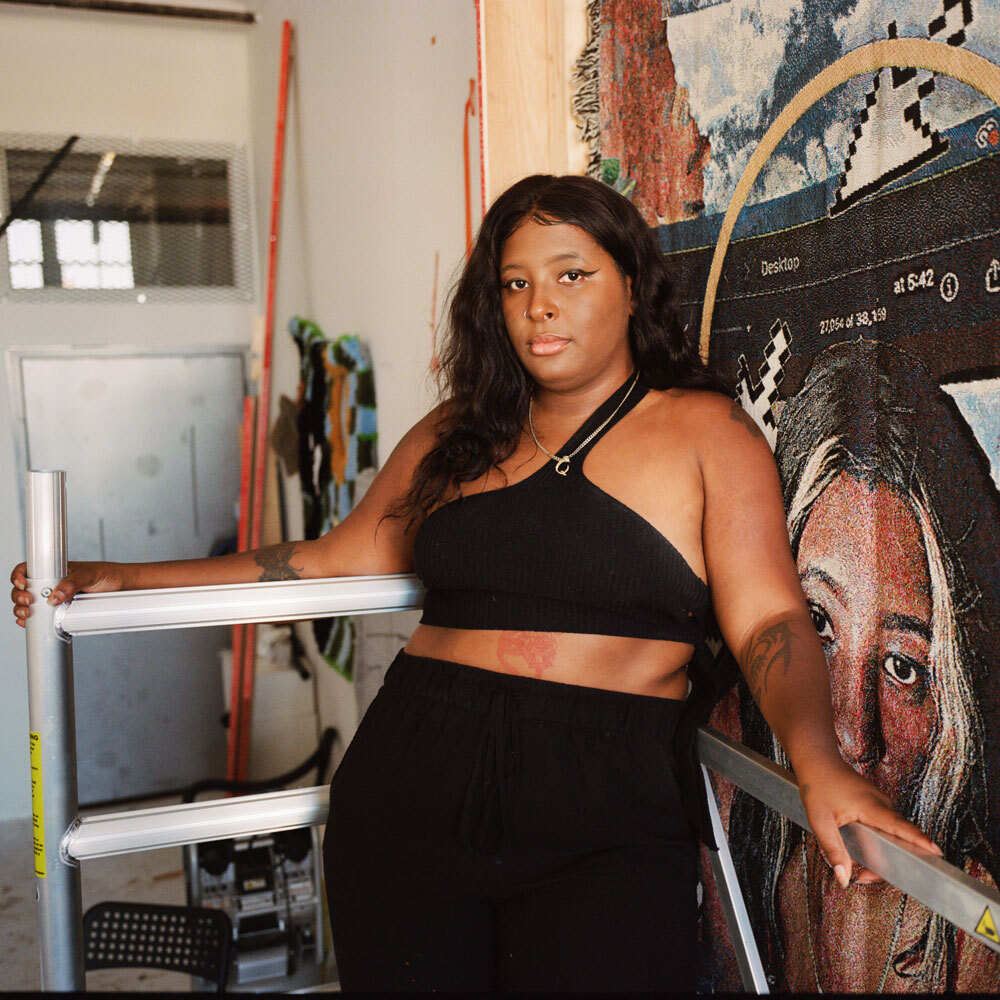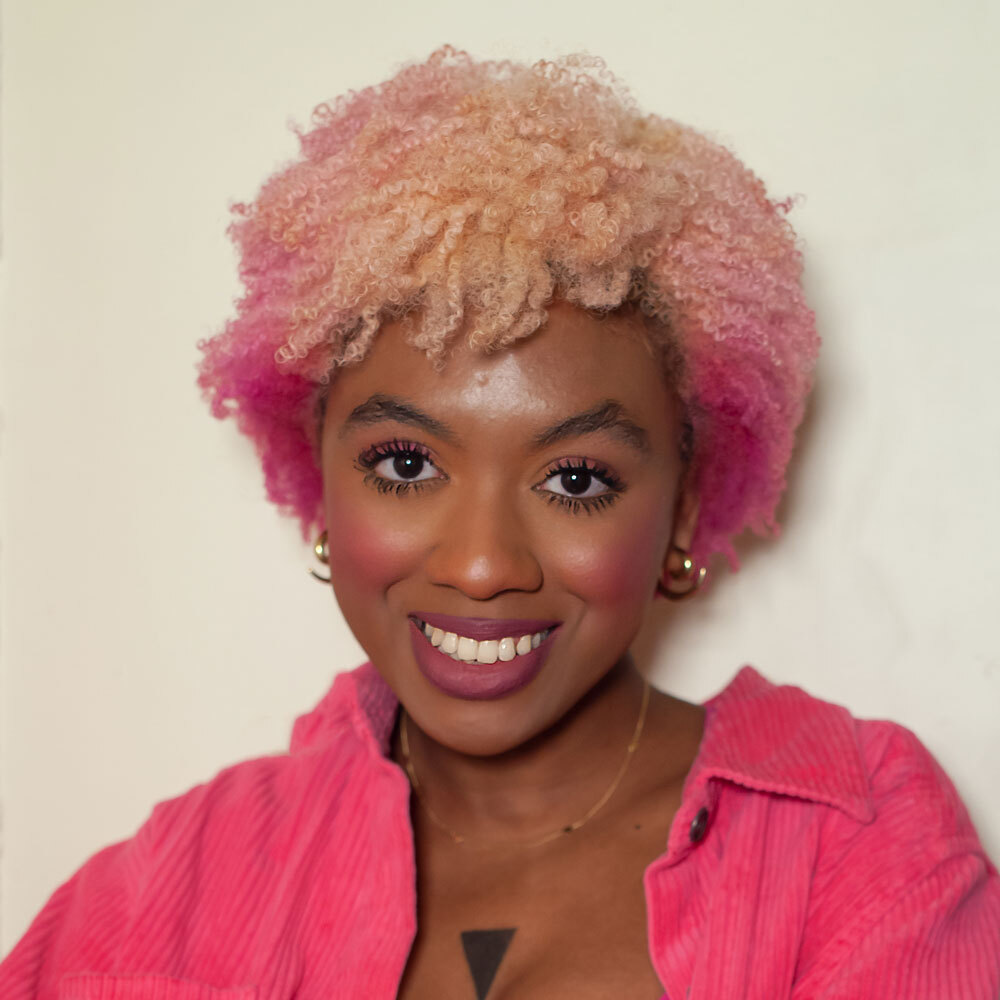Exploring the Future of Autonomy on the Internet
01.26.2023

Zoom
The Studio Museum in Harlem presents Exploring the Future of Autonomy on the Internet in support of Qualeasha Wood’s work in the exhibition It’s time for me to go: Studio Museum Artists in Residence 2021–22. Wood will be in conversation with artists Neema Githere and RaFia Santana, with Studio Museum Public Programs Coordinator Malanya Graham moderating. Topics explored will include creating safer virtual spaces, image making within the diaspora, and developing connections between physical and coded material. The conversation will begin with presentations by each artist, followed by an audience Q&A, and concluding with a screenshared video game.
Qualeasha Wood’s textile-based works explore the duality of being both celebrated and reviled by recognizing and amplifying the gaze cast upon her. She navigates both an internet environment saturated in Black femme figures and culture, and a political and economic environment that holds this embodiment at the margins.
Neema Githere’s practice centers digital diaspora, liberation, and self-documentation as worldmaking practices.
RaFia Santana’s work explores Black femme futures, acts of resistance against violence and suppression, and visual and sonic explorations of stereotypes.
It’s time for me to go is free and open to the public at MoMA PS1 through February 27, 2023.
Live CART captioning and ASL interpretation will be provided.

Exploring the Future of Autonomy Bios

Neema Githere
Neema Githere (b. Nairobi, Kenya) is an artist and guerrilla theorist whose work explores love and indigeneity in a time of algorithmic debris. Neema’s experimental practice, termed ‘data healing,’ seeks to illuminate the links between technology, nature, and spirituality to investigate how working from this intersection can combat the data trauma – a term coined by Olivia M. Ross – that saturates our virtual worlds. Other projects of Neema’s include Afropresentism, a term they coined in 2017 to articulate digital diasporic cultural production in the here and now.

Qualeasha Wood
Qualeasha Wood (b. 1996 Long Branch NJ; lives and works Brooklyn, NY) is a textile artist who’s work contemplates realities around black female embodiment that do and might exist. Wood utilizes a range of traditional craft and contemporary digital materials to create intricate aesthetic dialogues and offer novel perspective on the relationship between the avatar and the self.
Inspired by a familial relationship to textiles, queer craft, Microsoft Paint and internet avatars Qualeasha’s work begins to unravel the question of what is the place, purpose and hope for the non ontological black queer female body. By articulating and revisiting narratives of her own queer black experience, Qualeasha’s practice creates new dialogues across time and perspective, disillusioning past narratives of reality and shaping a new understanding of the black female experience. Wood holds a BFA in Printmaking from the Rhode Island School of Design, and a MFA in Photography from the Cranbrook Academy of Art.
Qualeasha was recently one of 200 visionaries invited to create a trunk for Louis Vuitton’s 200th birthday. Qualeasha has exhibited at Pippy Houldsworth Gallery, (London, UK); CANADA gallery (New York City); the Trout Museum of Art (Appleton, WI); solo at NADA Miami Beach 2020 with Kendra Jayne Patrick; Kendra Jayne Patrick for Metro Pictures (New York, NY); Cooper Cole (Toronto, ON); New Image Art (Los Angeles, CA); Gluon Gallery (Milwaukee, WI).

RaFia Santana
RAFiA SANTANA is a Brooklyn-based multidisciplinary artist specializing in graphic design, photography, animation, wordplay, music production, vocal performance, and multi-sensory stimulation as means to bend perception and make jokes. Their images and musical performances tackle topics of gentrification, self confidence and the regularity of racial & sexual violence while hypnotizing their audience with vibrant looping animations and catchy rhythms.
RAFiA also operates a fundraising initiative #PAYBLACKTiME that challenges people to individualize Reparations. Using their marketing skills and online network of followers, friends, and supporters they raised $10,000 they then used to send food orders and various means of support to Black & Brown people across the United States.
RaFia has exhibited their work at the Schomburg Center for Research in Black Culture, MoCADA, Tate Britain, the Museum of the Moving Image, and Times Square. They have been featured in Vogue, Teen Vogue, PAPER Magazine, VICE, Topical Cream Magazine, and other leading publications. They have performed & participated in panels, discussions, and events at Black Portraitures at Harvard University, Pratt Institute's Department of Digital Arts, Newspace Center for Photography, Afrotectopia at NYU's Tisch School of the Arts, & MoMA PS1.
Exploring the Future of Autonomy Playlist
Exploring the Future of Autonomy Additional Resources
It’s time for me to go: Studio Museum Artists in Residence 2021–22
Artist-in-Residence Open Studios | 2021–22
21 QUESTIONS: Qualeasha Wood Wants to Get Crab Legs with Cardi B
A Life in Pink: Artist RaFia Santana on Her (Mostly) Magenta Wardrobe
Neema Githere Dreaming Black Futures Symposium
Qualeasha Wood: Ideal Selfie
2021-22 AIR program funder credits
The Studio Museum in Harlem’s Artist-in-Residence program is supported by the Glenstone Foundation; The American Express Kenneth and Kathryn Chenault Sponsorship Fund; National Endowment for the Arts; Joy of Giving Something; Robert Lehman Foundation; New York State Council on the Arts; Doris Duke Charitable Foundation; Jerome Foundation; Anonymous; Milton and Sally Avery Arts Foundation; and by endowments established by the Andrea Frank Foundation; the Jacob and Gwendolyn Knight Lawrence Trust; and Rockefeller Brothers Fund. Support for It’s time for me to go at MoMA PS1 is generously provided by the Tom Slaughter Exhibition Fund and the MoMA PS1 Trustee Annual Fund.
The Studio Museum in Harlem’s Learning and Engagement programs are supported by the Thompson Foundation Education Fund; Van Cleef & Arpels; William R. Kenan, Jr. Charitable Trust; Con Edison; Harlem Community Development Corporation; May and Samuel Rudin Family Foundation; Sony Music Group; and Joseph and Joan Cullman Foundation for the Arts.
Additional support provided by the New York City Department of Cultural Affairs and New York State Council on the Arts.
Exploring the Future of Autonomy on the Internet
01.26.2023

Zoom
The Studio Museum in Harlem presents Exploring the Future of Autonomy on the Internet in support of Qualeasha Wood’s work in the exhibition It’s time for me to go: Studio Museum Artists in Residence 2021–22. Wood will be in conversation with artists Neema Githere and RaFia Santana, with Studio Museum Public Programs Coordinator Malanya Graham moderating. Topics explored will include creating safer virtual spaces, image making within the diaspora, and developing connections between physical and coded material. The conversation will begin with presentations by each artist, followed by an audience Q&A, and concluding with a screenshared video game.
Qualeasha Wood’s textile-based works explore the duality of being both celebrated and reviled by recognizing and amplifying the gaze cast upon her. She navigates both an internet environment saturated in Black femme figures and culture, and a political and economic environment that holds this embodiment at the margins.
Neema Githere’s practice centers digital diaspora, liberation, and self-documentation as worldmaking practices.
RaFia Santana’s work explores Black femme futures, acts of resistance against violence and suppression, and visual and sonic explorations of stereotypes.
It’s time for me to go is free and open to the public at MoMA PS1 through February 27, 2023.
Live CART captioning and ASL interpretation will be provided.

Exploring the Future of Autonomy Bios

Neema Githere
Neema Githere (b. Nairobi, Kenya) is an artist and guerrilla theorist whose work explores love and indigeneity in a time of algorithmic debris. Neema’s experimental practice, termed ‘data healing,’ seeks to illuminate the links between technology, nature, and spirituality to investigate how working from this intersection can combat the data trauma – a term coined by Olivia M. Ross – that saturates our virtual worlds. Other projects of Neema’s include Afropresentism, a term they coined in 2017 to articulate digital diasporic cultural production in the here and now.

Qualeasha Wood
Qualeasha Wood (b. 1996 Long Branch NJ; lives and works Brooklyn, NY) is a textile artist who’s work contemplates realities around black female embodiment that do and might exist. Wood utilizes a range of traditional craft and contemporary digital materials to create intricate aesthetic dialogues and offer novel perspective on the relationship between the avatar and the self.
Inspired by a familial relationship to textiles, queer craft, Microsoft Paint and internet avatars Qualeasha’s work begins to unravel the question of what is the place, purpose and hope for the non ontological black queer female body. By articulating and revisiting narratives of her own queer black experience, Qualeasha’s practice creates new dialogues across time and perspective, disillusioning past narratives of reality and shaping a new understanding of the black female experience. Wood holds a BFA in Printmaking from the Rhode Island School of Design, and a MFA in Photography from the Cranbrook Academy of Art.
Qualeasha was recently one of 200 visionaries invited to create a trunk for Louis Vuitton’s 200th birthday. Qualeasha has exhibited at Pippy Houldsworth Gallery, (London, UK); CANADA gallery (New York City); the Trout Museum of Art (Appleton, WI); solo at NADA Miami Beach 2020 with Kendra Jayne Patrick; Kendra Jayne Patrick for Metro Pictures (New York, NY); Cooper Cole (Toronto, ON); New Image Art (Los Angeles, CA); Gluon Gallery (Milwaukee, WI).

RaFia Santana
RAFiA SANTANA is a Brooklyn-based multidisciplinary artist specializing in graphic design, photography, animation, wordplay, music production, vocal performance, and multi-sensory stimulation as means to bend perception and make jokes. Their images and musical performances tackle topics of gentrification, self confidence and the regularity of racial & sexual violence while hypnotizing their audience with vibrant looping animations and catchy rhythms.
RAFiA also operates a fundraising initiative #PAYBLACKTiME that challenges people to individualize Reparations. Using their marketing skills and online network of followers, friends, and supporters they raised $10,000 they then used to send food orders and various means of support to Black & Brown people across the United States.
RaFia has exhibited their work at the Schomburg Center for Research in Black Culture, MoCADA, Tate Britain, the Museum of the Moving Image, and Times Square. They have been featured in Vogue, Teen Vogue, PAPER Magazine, VICE, Topical Cream Magazine, and other leading publications. They have performed & participated in panels, discussions, and events at Black Portraitures at Harvard University, Pratt Institute's Department of Digital Arts, Newspace Center for Photography, Afrotectopia at NYU's Tisch School of the Arts, & MoMA PS1.
Exploring the Future of Autonomy Playlist
Exploring the Future of Autonomy Additional Resources
It’s time for me to go: Studio Museum Artists in Residence 2021–22
Artist-in-Residence Open Studios | 2021–22
21 QUESTIONS: Qualeasha Wood Wants to Get Crab Legs with Cardi B
A Life in Pink: Artist RaFia Santana on Her (Mostly) Magenta Wardrobe
Neema Githere Dreaming Black Futures Symposium
Qualeasha Wood: Ideal Selfie
2021-22 AIR program funder credits
The Studio Museum in Harlem’s Artist-in-Residence program is supported by the Glenstone Foundation; The American Express Kenneth and Kathryn Chenault Sponsorship Fund; National Endowment for the Arts; Joy of Giving Something; Robert Lehman Foundation; New York State Council on the Arts; Doris Duke Charitable Foundation; Jerome Foundation; Anonymous; Milton and Sally Avery Arts Foundation; and by endowments established by the Andrea Frank Foundation; the Jacob and Gwendolyn Knight Lawrence Trust; and Rockefeller Brothers Fund. Support for It’s time for me to go at MoMA PS1 is generously provided by the Tom Slaughter Exhibition Fund and the MoMA PS1 Trustee Annual Fund.
The Studio Museum in Harlem’s Learning and Engagement programs are supported by the Thompson Foundation Education Fund; Van Cleef & Arpels; William R. Kenan, Jr. Charitable Trust; Con Edison; Harlem Community Development Corporation; May and Samuel Rudin Family Foundation; Sony Music Group; and Joseph and Joan Cullman Foundation for the Arts.
Additional support provided by the New York City Department of Cultural Affairs and New York State Council on the Arts.
Zoom